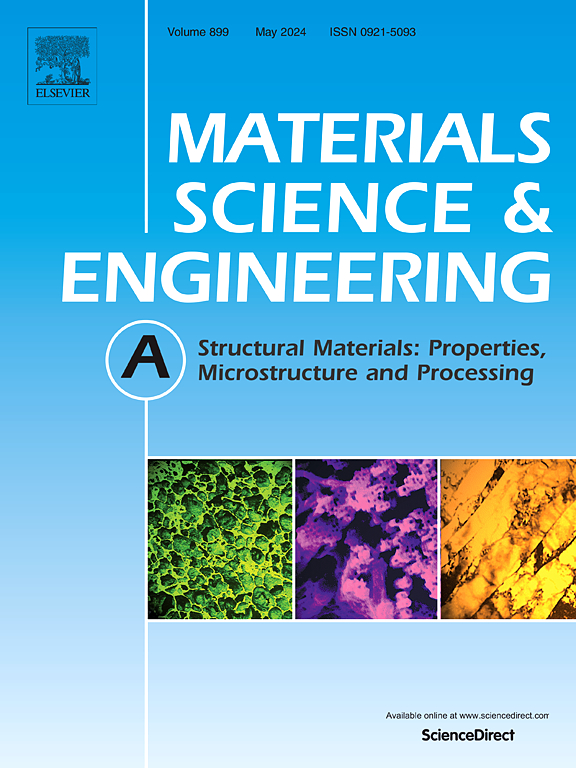搅拌摩擦粉添加剂制备的氧化锆和聚合物陶瓷增强AA7075复合材料的力学和微观结构行为
IF 7
2区 材料科学
Q1 MATERIALS SCIENCE, MULTIDISCIPLINARY
引用次数: 0
摘要
铝基复合材料的熔融增材制造面临着氧化、热裂、冶金不相容以及由于液固相转变而产生的脆性金属间形成等挑战。另一方面,基于固体摩擦搅拌的增材制造工艺最大限度地减少了这些问题,但受到合适原料形式的可用性的限制,特别是用于制造复合材料。最近开发的摩擦搅拌粉末增材制造(FSPAM)是一种新兴的固态增材制造工艺,它减少了与固化相关的问题,并通过使用现成的粉末克服了原料的限制,通过粉末混合可以轻松制备复合原料。本研究研究了使用FSPAM工艺制备的氧化锆和聚合物衍生陶瓷增强AA7075复合材料。显微组织证实了一种均匀、无缺陷的沉积,晶粒尺寸为6.4±2.9μm,高角度晶界占58%,表明动态再结晶使晶粒细化。强化颗粒通过齐纳钉钉效应细化了显微组织,而η和S相(~ 45 nm尺寸)通过抑制晶粒粗化提高了机械强度。复合材料的屈服强度为223±7 MPa,极限抗拉强度为393±3 MPa,显微硬度为125±9 HV,与AA7075-T4合金相匹配。然而,延伸率限制在5.5±0.4%,可能是由于局部增强颗粒的团聚。这些发现强调了FSPAM在铝基复合材料的高强度和高温固态增材制造中是一种很有前途的工艺,尽管需要进一步的研究来解决更广泛的工业应用的几何限制。本文章由计算机程序翻译,如有差异,请以英文原文为准。
Mechanical and microstructural behavior of friction stir powder additive manufactured ceria-stabilized zirconia and polymer-derived ceramic reinforced AA7075 composites
Fusion-based additive manufacturing of Al-based composites faces challenges such as oxidation, hot cracking, metallurgical incompatibility, and brittle intermetallic formation due to liquid-solid phase transformations. Solid-state friction stir-based AM processes, on the other hand, minimize these issues but are limited by the availability of suitable feedstock forms, especially for manufacturing composites. Recently developed friction stir powder additive manufacturing (FSPAM) is an emerging solid-state additive manufacturing process that reduces solidification-related issues and overcomes feedstock limitations by using readily available powders, allowing easy preparation of composite feedstocks through powder mixing. This study investigates ceria-stabilized zirconia and polymer-derived ceramic-reinforced AA7075 composites manufactured using the FSPAM process. Microstructure confirmed a uniform, defect-free deposition having fine grains of size 6.4 ± 2.9μm and 58 % high-angle grain boundaries, indicating significant grain refinement due to dynamic recrystallization. The reinforcement particles refined the microstructure through the Zener pinning effect, while η and S precipitates (∼45 nm size) enhanced mechanical strength by inhibiting grain coarsening. The composite exhibited a yield strength of 223 ± 7 MPa, an ultimate tensile strength of 393 ± 3 MPa, and a microhardness of 125 ± 9 HV, closely matching AA7075-T4 alloys. However, elongation was limited to 5.5 ± 0.4 %, possibly due to localized agglomeration of reinforced particles. These findings highlight FSPAM as a promising process in solid-state AM of Al-based composites for high-strength and high-temperature applications, though further research is needed to address geometric constraints for broader industrial adoption.
求助全文
通过发布文献求助,成功后即可免费获取论文全文。
去求助
来源期刊

Materials Science and Engineering: A
工程技术-材料科学:综合
CiteScore
11.50
自引率
15.60%
发文量
1811
审稿时长
31 days
期刊介绍:
Materials Science and Engineering A provides an international medium for the publication of theoretical and experimental studies related to the load-bearing capacity of materials as influenced by their basic properties, processing history, microstructure and operating environment. Appropriate submissions to Materials Science and Engineering A should include scientific and/or engineering factors which affect the microstructure - strength relationships of materials and report the changes to mechanical behavior.
 求助内容:
求助内容: 应助结果提醒方式:
应助结果提醒方式:


